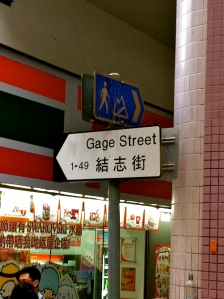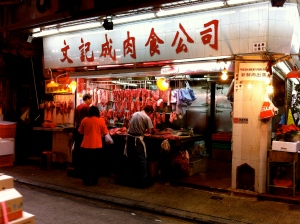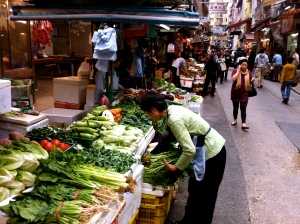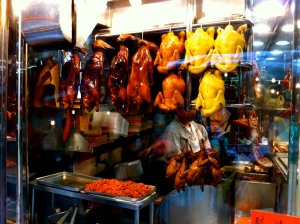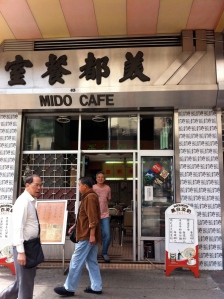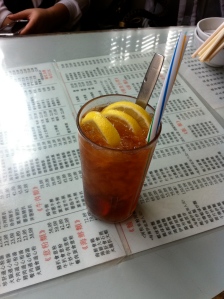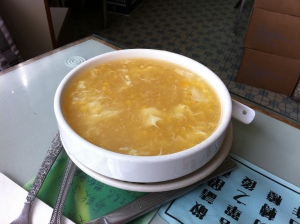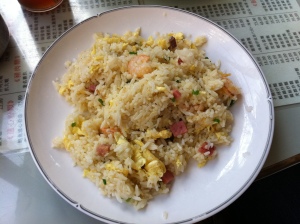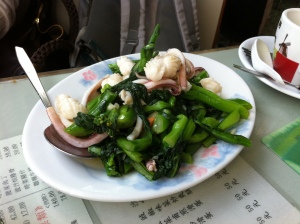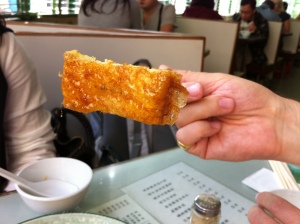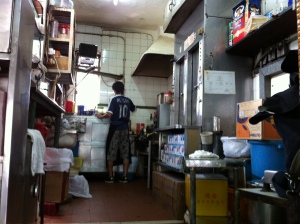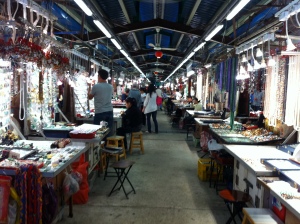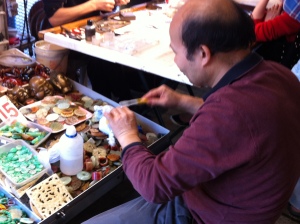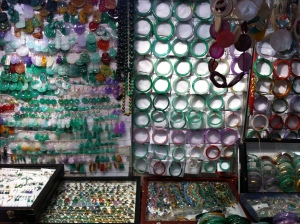Mido Cafe
A part of local Hong Kong life are the cha-chan-tengs or “tea food halls”. They are basically small diners, that serve a unique blend of Western and Chinese cuisine. The food is usually very simple, e.g. Instant Noodles w/ canned Luncheon Pork, and is also very cheap.
Exterior of Mido Cafe with daily specials displayed outside the cafe.
Mido Cafe is one of Hong Kong’s authentic cha chaan tengs, and has been around for around six decades. During lunch hour, the cafe is packed with busy commuters, so we went there at around eleven o’clock.
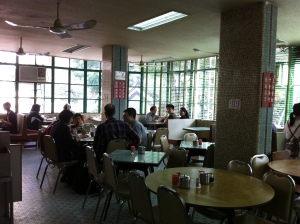
The restaurant had a great retro atmosphere, and was covered floor to ceiling with tiles of an array of dazzling colours.
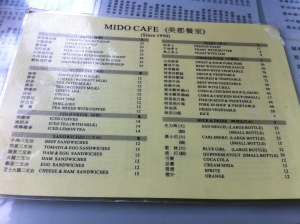
The menu, showing the many dishes on offer for reasonable prices.
After asking the waiter for recommendations, we all ordered Ice Lemon Teas ($12 each) as drinks. Ice Lemon Tea is a popular drink amongst all Hong Kongers, young and old. It is tangy and refreshing, and really cools you down. We then decided on eating the daily special, Stir Fried Kale and Squid ($60), followed by Yeung Chow Fried Rice ($30), and Sweet Corn and Chicken Soup ($17 for small portion).
All the food was prepared and cooked in roughly ten minutes.
Iced Lemon Tea.
Sweet Corn and Chicken Soup.
The Sweet Corn and Chicken Soup was thick and creamy with a hot and sour taste. It was definitely a great pick, and of excellent value for money.
Yeung Chow Fried Rice is probably one of the simplest dishes in local Hong Kong cuisine, but it is also the most popular. The variation of Yeung Chow Fried Rice I had was basically a mixture of fresh prawns, pork, scrambled eggs, ham and rice.
Stir-fried Kale and Squid.
The blend of crunchy, fresh kale and the succulent squid creates a perfect dish. The whole plate was gone in seconds!
French Toast.
For dessert, we decided to order the daily special, “Western Style French Toast”. Overall, there was a good balance between the rich honey taste and the eggy flavour, but I did feel that the French Toast was a bit on the greasy side.
For dessert, we decided to order the daily special, “Westen Style French Toast”.
Kitchen, where the food is prepared.
In conclusion, if you want to experience the real Hong Kong life, the cha chaan tengs are a part you cannot miss!
Jade Market
A view of the market’s many stalls.
In Chinese culture, jade symbolizes beauty and purity. That’s why it has been traded so widely throughout various Asian countries such as Burma, China, Singapore and Malaysia.
The Jade Market in Yau Ma Tei is one of the most iconic sites in Hong Kong. Four hundred vendors selling jade products, predominantly from Myanmar, are crammed into this small indoor bazaar. Apart from jade, pearls and other precious stones from the South East Asian region can also be bought.
Man polishing piece of jade with a toothbrush.
The Jade Market wasn’t as busy as I thought it would be; in fact, when I was walking down the aisles I noticed that some vendors had signs hanging down in front of their stalls saying, “We are out of business! Please help us by buying jade necklace, special price starting from $10”. The stall keepers tried to advertise their jade products to me by shouting random phrases like, “Good price”, “high quality” and “very beautiful!”. There was obviously a very competitive atmosphere here, as all of the vendors were trying their very best to attract my attention.
The massive array of jade products stunned me. There was literally everything you could imagine on sale – in jade. Jade necklaces, jade keyrings, jade paperweights, jade busts, jade statuettes; you name it. Also, everything was CHEAP! However, I had learnt from the Hong Kong Tourism Board’s website (http://www.discoverhongkong.com/eng/attractions/kln-jade-market.html) that most of the jade was dyed, to ‘enhance the colour’. So, at the end of the day, you get what you pay for!
